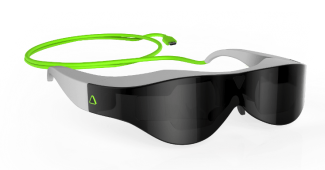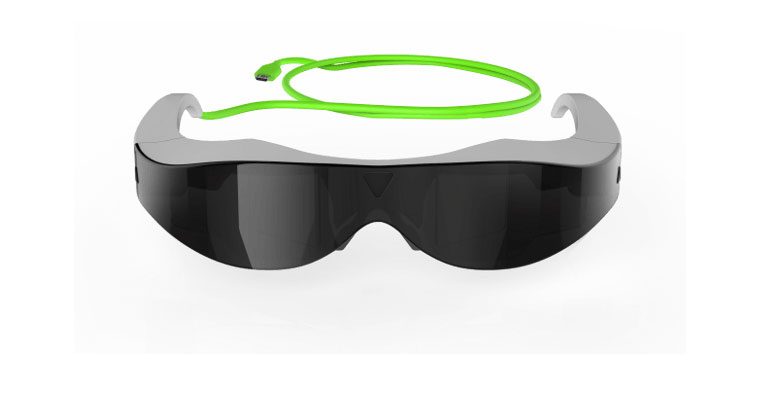
Atheer Labs, a maker of smart glasses with gesture recognition, recently completed a successful Indiegogo campaign, raising $214,407 of their $100,000 goal. Road to VR’s Brian Hart recently visited their Mountain View, CA, office and sat down with Senior Product Manager Theo Goguely to learn more about Atheer’s technology, and the world of smart glasses.
Road to VR: Tell us about the company. What was the initial idea?
TG: The initial problem that’s trying to be solved is this constraint that exists with today’s devices where the size of your interface and display is constrained by the size of your device… which sounds pretty straightforward because that’s essentially all the devices we’ve know up to today except for projectors. Projectors are a reasonably small-ish device that can give you really large display. And so that’s what we’re trying to do, is provide a small device that provides you with a large interaction space—both display space and interaction space for your hands.
Road to VR: How is Atheer approaching this problem?

TG: There are two products that we’re building right now. The first one is the Atheer dev kit. It’s a lightweight pair of glasses with see-through displays and onboard sensors, and it comes with a connected box (which we call the wallet), which is its own fully-functioning Android device. In it you’ll find a Snapdragon processor, a battery, WiFi and Bluetooth connectivity, and all the accelerometers, GPS and other sensors you would expect to find in a modern smartphone. The only thing it doesn’t have is an LCD touchscreen like you would have on any other Android device. So your interface to the Android system is done through the glasses. It being developer focused, we’ve included a full-size USB port so that you can plug in a USB mouse or keyboard, or whatever other auxiliary controllers you may need.

The second device which we’re building is more consumer-based, is the Atheer One, and that one will connect to your existing Android smartphone for all its Android and processing needs. So you’ll be able to take your Nexus 5 or a Galaxy S4, and plug the Atheer One into it like a supercharged accessory. Initially you will have a mirroring of your standard Android desktop in your glasses, the same way people can plug in their phone using MHL or SlimPort to connect to a TV, but you will be able to control the phone through the gesture detection done on the glasses.
Road to VR: Your support of gestures is a key differentiator from other wearables like Google Glass, so I expect you’re spending a lot of energy getting gesture recognition right. What’s involved in that?
TG: Fundamentally, what people know of gestures is typically Leap Motion and Kinect. Those are the two most popular and widely known products. They kind of went down a different path because of the hardware they had available to them. The Kinect runs off an XBOX, Leap Motion runs off your PC. Both of those have huge CPU’s, huge GPU’s available to them to do all this computation. We’re trying to do this on a mobile processor that, by the way, also needs to run your app.
When you have a camera on a device like a Kinect, a Leap Motion, a tablet, a phone, and you’re interacting with it with a gesture, that device isn’t moving. It’s on a table, it’s on the wall, and so your background is always fixed. For gesture detection, that is a huge advantage, because you have this normal state and you can pick out the things that weren’t there before. What we’re doing, we’re mounting this 3D sensor on your forehead and you’re moving around, you’re going up and down, and your background is changing all the time, so you can’t use that technique. We’re having to go at [gesture detection] from a different point of view. We have to be very accurate because we’re dealing with a lot of random noise.
Road to VR: Speaking of Leap Motion, they have an SDK, and I think they hoped the apps would come…
TG: It didn’t really happen.
Road to VR: So how will Atheer avoid that?
TG: Part of the issue that we saw Leap Motion run into is that they’re providing a new interface and interaction mechanism for PCs but the display and UI you’re interacting with is not changing. The content for PCs, notably applications and UI, has been optimized for years based on the existing input mechanisms, notably the mouse and keyboard. These two are fundamentally tied at the hip and if you try and change one while keeping the other the same, a lot of times it doesn’t work.
A good example of this is when the first Windows XP tablets or convertible laptops came out, using resistive touchscreens or a stylus. This was back in the early 2000s, and people were excited about these laptops where they didn’t need to use the mouse an keyboard anymore to control them. So now you’ve got this awesome new interface, but the display and the UI are the same as before, and it just didn’t work outside of a couple niche markets. So what’s the difference between that old Windows XP touchscreen laptop and todays iPad? It’s that the iPad OS, UI and experience was purpose-built to be controlled intuitively through a high quality capacitive touchscreen. And so that’s kind of what we’re doing with our 3D displays and gesture detection. Yes, we’re using gestures similar to Leap Motion, but we’re creating the device UI and experience in 3D such that it is natural to being navigated via gestures. It’s important that we convey these design concepts and principles to all of our developers as well, as it requires a mental shift of what is possible and normal from your previous smartphone or tablet experience.
“..anyone can go out and download our SDK today, and start creating an application for our glasses”
Road to VR: So at this stage, it’s about getting the SDK out to developers and letting their imaginations run wild.
TG: Correct, we’re really focusing on creating the best platform possible, both on the OS/UI side and the physical glasses, and as such can’t tackle all of the crazy app ideas that come through our heads during this process. One thing we’ve done is that anyone can go out and download our SDK today, and start creating an application for our glasses. Now of course without a pair of glasses it’s tough to visualize what it will actually look like, but we wanted everybody to have the opportunity to work on their ideas, as we knew our glasses aren’t necessarily going to be affordable for all the developers who have great ideas. For someone who is serious in the AR space and especially in the industrial and commercial side of things, price is much less of a concern but we’re trying to make it available for everyone. For a casual developer or hacker who wants to play around with it, it’s a pretty serious investment, so we’ve made our SDK completely free, which includes emulators that can run on Android devices. So, for example, if you have a Nexus phone or a tablet, you can run an emulator for our glasses so that you can develop an app using our SDK and run it on an emulator tablet to make full use of the sensors in the tablet. You can do a lot of the AR work, using the accelerometers and camera from the tablet, and it’s letting you discover and explore this world without having to spend money upfront.
Road to VR: Say I’m an early backer, I get my [developer kit] at the end of April, I unbox it. What is my relationship with Atheer at that point?
TG: Hopefully before you get your Developer Kit you’ve already registered and logged onto our portal, and downloaded the SDK, set up your environment, tried some of the sample code we’ve included, browsed through our documentation, gotten familiar with our APIs, and with a lot of concepts that we’re introducing. We want the early developers to be able to hit the ground running when they receive their glasses, and are ready to answer any specific questions sent to developers@atheerlabs.com to help them figure things out.
Thank you to Atheer Labs and Theo Goguely for taking the time to speak with us.
Atheer is currently offering the Developer Kit for $850 with shipment June 2014, and the Atheer One for $500 with shipment December 2014 – both can be pre-ordered at their website.
Full Disclosure: The author contributed to the Atheer Indiegogo campaign at the “$10 – Thanks!” level.







